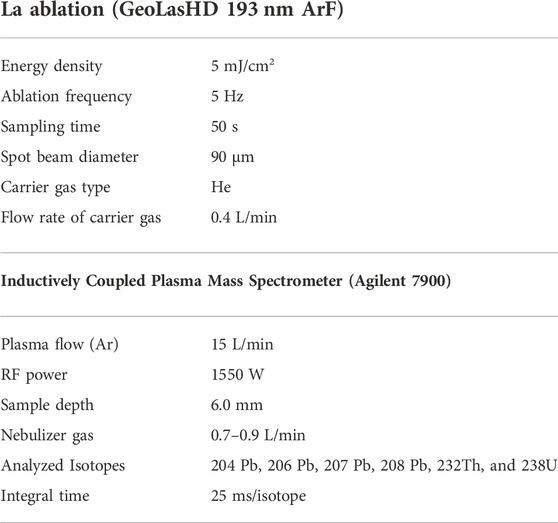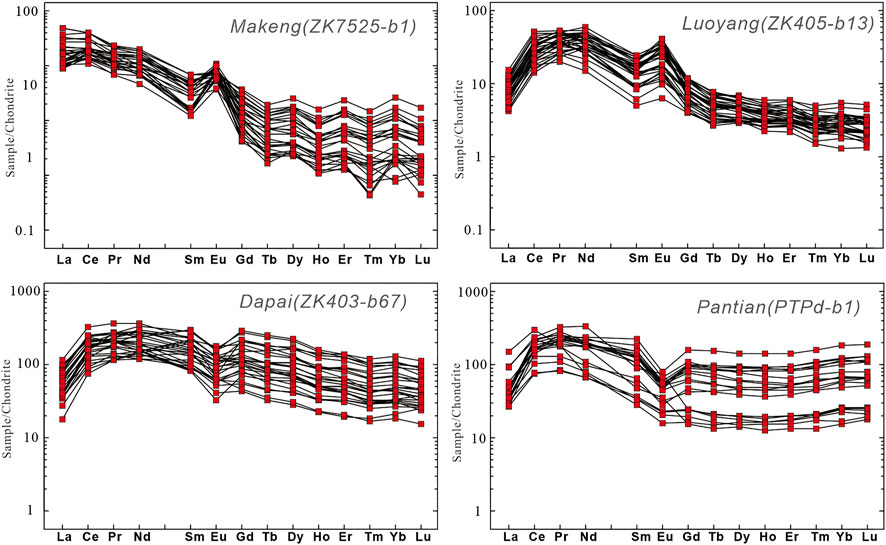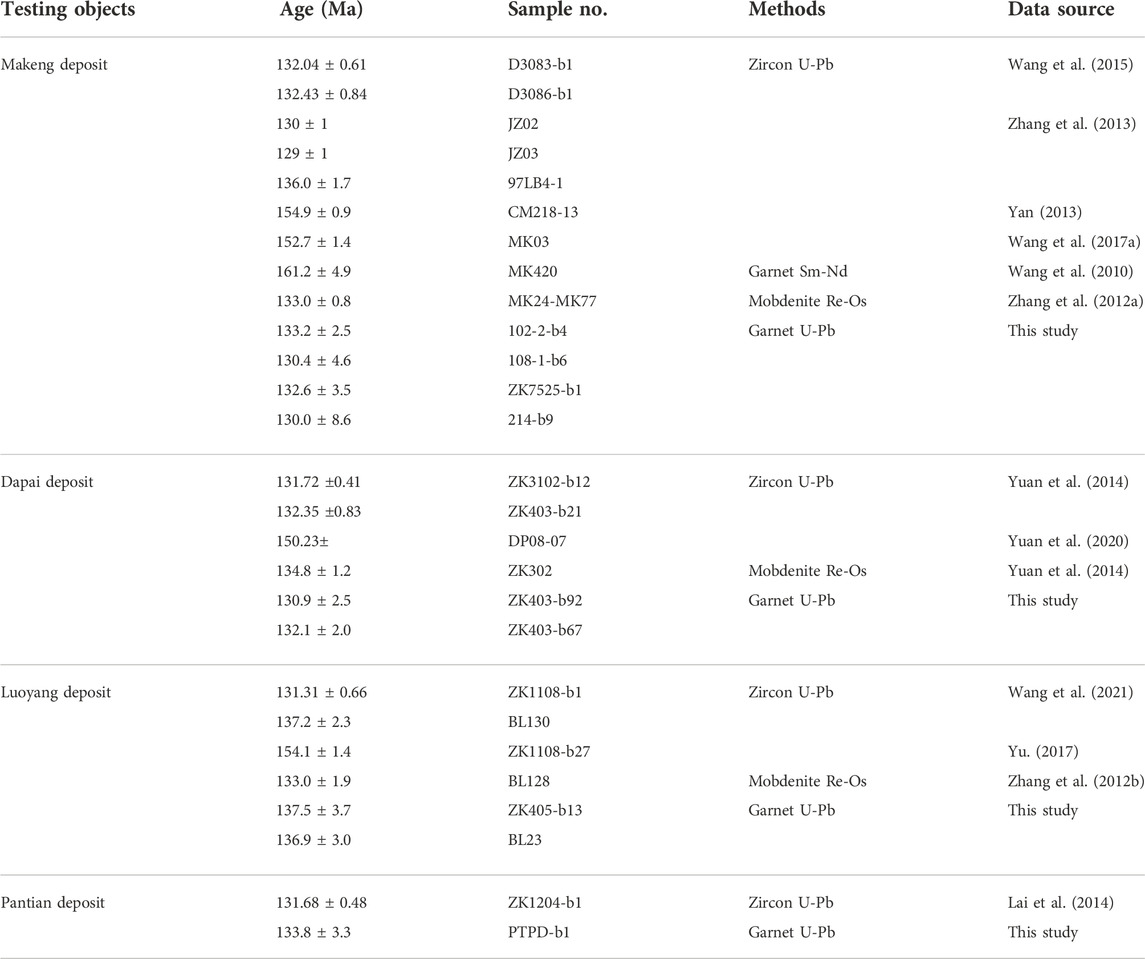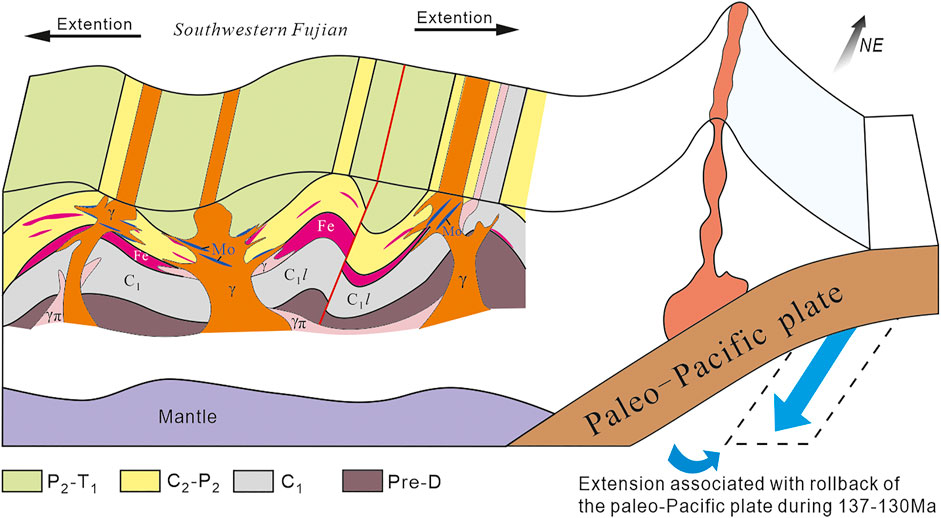- 1Institute of Geomechanics, Chinese Academy of Geological Sciences, Beijing, China
- 2Key Laboratory of Paleomagnetism and Tectonic Reconstruction, Ministry of Natural Resources, Beijing, China
- 3Research Center of Polar Geosciences, China Geological Survey, Beijing, China
- 4Beijing Research Institute of Uranium Geology, Beijing, China
- 5China University of Geosciences (Beijing), Beijing, China
- 6Cores and Samples Centre of Natural Resources, China Geological Survey, Sanhe, China
To reveal the genesis of Makeng-style iron polymetallic deposits from SE China in the paleo-Pacific tectonic domain, a new analytical method of LA-ICPMS garnet U-Pb dating and rare Earth element analysis was conducted for the Makeng, Luoyang, Dapai and Pantian deposits. The U-Pb dating results of nine garnet skarn samples from these deposits suggested that the Makeng-style iron polymetallic deposits mainly formed during 137–130 Ma, which is consistent with the zircon U-Pb and molybdenite Re-Os ages. This study provides more direct evidence of the mineralization age and the relationship between mineralization and granite, compared with previous studies on the zircon U-Pb dating for granites in the ore fields. Rare Earth element (REE) analysis results and REE patterns of four representative garnet samples from the Makeng, Luoyang, Dapai and Pantian deposits show that they are similar to typical skarn deposits, but obvious differences in the REE distribution types indicate that the ore-forming process may be distinct due to different mineralizing fluid for these Makeng-style deposits. Our new garnet U-Pb dating and rare Earth element analysis result not only provides new evidence for the mineralization age and genesis of the Makeng-style deposits but is also of great significance to promote the application of U-Pb dating methods to research skarn type deposits.
Introduction
The Southwestern Fujian Iron Polymetallic Metallogenic Belt (SFIPMB) is one of the most important mineralization zones in the Southeast China Block of the paleo-Pacific tectonic domain (Figure 1A), and abundant iron deposits were hosted along this belt, such as the Makeng, Dapai, Pantian, Luoyang, Yangshan, Tangquan, and Zhongjia deposits (Figure 1B). These deposits are typically referred to as “Makeng-style iron deposits” due to their spatial and genetic association with the super large scale Makeng iron polymetallic deposit (Zhang et al., 2018a; Wang et al., 2018a; Wang et al., 2021). These deposits have similar metallogenic characteristics, and ore bodies are usually found between the early Carboniferous siliceous clastic rocks and late Carboniferous - middle Permian limestones with stratiform or stratoid shapes and large sizes. Many studies have been performed on the genesis of Makeng-style iron polymetallic deposits (Han and Ge, 1983; Zhang et al., 2018a; Zhang et al., 2013; Zhang and Zhang, 2014; Zhang and Zuo, 2014; Zhang et al., 2015; Wang et al., 2017a; Yang et al., 2017; Wang et al., 2018a), but controversy remain due to different understanding on the mineralization age. Some scholars held on the idea that the mineralization of the Makeng-style iron deposit was related to Early Cretaceous granites (ca. 135–130 Ma, Zhang et al., 2018a; Zhang et al., 2013; Zhang et al., 2018a). However, other scholars put forward different opinions on the mineralization age according to the relationship between the magnetite orebodies and other wall rocks, and provided chronological evidences of 160–150 Ma (Wang et al., 2010; Yan, 2013; Zhang et al., 2015; Wang et al., 2017a). Especially in the last few years, zircon U-Pb ages of 160–150 Ma for granites from these Makeng-style deposits were reported, such as 154.9 ± 0.9 Ma for Makeng deposit (Yan, 2013), 152.7 ± 1.4 Ma for the Luoyang deposit (Yu, 2017), and 150.2 ± 0.5 Ma for Dapai deposit (Yuan et al., 2020). Together with garnet Sm-Nd ages (157 ± 15 Ma, Zhang et al., 2015), zircon U-Pb ages of granites and basic rocks suggested that the mineralization may occur at 160–150 Ma (Yan, 2013; Zhang et al., 2015; Wang et al., 2017a; Yu, 2017; Yuan et al., 2020). To sum up, there are two main viewpoints on the mineralization age for the Makeng-style deposits due to different research objects and analytical methods they selected. In addition, different understandings on the mineralization age further affects explanations of the ore genesis, and therefore, the controversy on the mineralization age for the Makeng-style deposits needs to be solved urgently. Garnet-magnetite and diopside-magnetite are the major ore types with massive and banded structures for these Makeng-style deposits. The garnets are mainly andradites and closely associated with the magnetites in space. These garnets usually have good crystal shapes, and they are accompanied by xenomorphic magnetites. At present, it is impossible to carry out direct dating on magnetites, and therefore, the dating research on garnets can provide more direct constrains on the mineralization age due to their close spatial relationship with magnetites. Along with the development of laser ablation inductively coupled plasma-mass spectrometry (LA-ICPMS), in-situ garnet U-Pb isotope analysis has been gradually realized (Chen et al., 2016; Deng et al., 2017; Seman et al., 2017; Tang et al., 2021). As a main kind of skarn mineral, garnet has been used in dating research the skarn type deposits and yields accurate U-Pb ages (Deng et al., 2017; Li et al., 2018; Wafforn et al., 2018; Stifeeva et al., 2019; Duan et al., 2020; Tang et al., 2021). In this paper, ore-bearing skarns were selected from the Makeng, Luoyang, Dapai and Pantian deposits to carry out garnet U-Pb dating and rare Earth element analysis research and provide new evidence on the mineralization age and ore genesis for the Makeng-style iron polymetallic deposits. This research not only provides new chronology and geochemical evidence for the generation of the Makeng-style deposits but is also of great significance to promote the application of new U-Pb dating methods to the study of skarn type deposits.
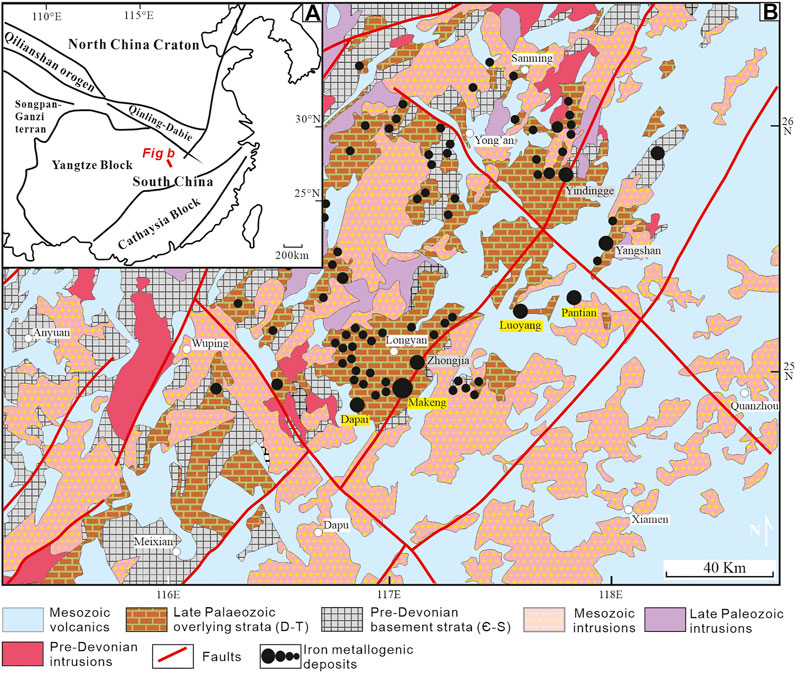
FIGURE 1. Tectonic sketch map showing the location of the study area (A) and regional geological map of southwest Fujian and the location of Makeng-style deposits (B).
Regional geological setting
The global tectonic pattern underwent some major changes with frequent magmatic-polymetallic mineralization in eastern China during the Yanshanian period. Located in the eastern part of the South China Plate, the southwestern Fujian area has been affected by the subduction of the Pacific Plate since the Mesozoic and Cenozoic, and the metallogenic domains of the circum-Pacific have occurred with large-scale copper, molybdenum, iron, gold silver, lead and zinc mineralization, such as the Zijinshan copper-gold deposit and Makeng iron deposit.
Located on the western margin of the Paleo-Pacific tectonic domain, the Makeng-style deposits are important iron polymetallic ore deposits in the SE China. These iron polymetallic ores are controlled by regional structures with an obvious NE-trending distribution (Figure 1). Sedimentary rocks distributed in the metallogenic belt are mainly.
The following three types in general: pre-Devonian basement rocks, late Paleozoic-middle Triassic clastic sedimentary and cap carbonate strata, and Mesozoic continental clastic and volcanic rocks (Wang et al., 2017b). Among these rocks, Early Carboniferous siliceous clastic rocks and Late Carboniferous - middle Permian limestones are most closely related to the iron polymetallic ore bodies in space (Figure 2). The iron polymetallic metallogenic belt is a most important part of the Mesozoic tectonic-magmatic zone on the west side of the Pacific plate. Mesozoic acidic and intermediate-acidic magmatic rocks are widely developed in the ore districts of Makeng-style deposits, with U-Pb ages mainly ranging from 135 to 130 and 160 to 150 (Wang et al., 2015). These intrusive rocks are closely related to the magnetite ore bodies in space, but there is a lack of direct evidence for the relationship between them. The iron orebodies mainly occurred in the garnet skarn and obviously controlled by strata, not in the contact zone of the granites. The Makeng-style iron polymetallic deposits are accompanied by Mo-, Pb- and Zn-bearing minerals, and previous studies have demonstrated that the molybdenite formed during 135–130 Ma (Zhang et al., 2018a; Zhang et al., 2012b); however, unlike the magnetites, molybdenites were only found within the granite bodies and in the fracture surface of wall rocks and iron ores. Therefore, there is no direct evidence to suggest that the molybdenite is contemporaneous with magnetite. The Early Cretaceous granites are the major magmatic rocks in the SFIPMB (Figure 2), and they are most likely metallogenic rocks; however, there is no direct evidence to verify that the iron mineralization is related to the Cretaceous granite, especially for the Makeng deposit.
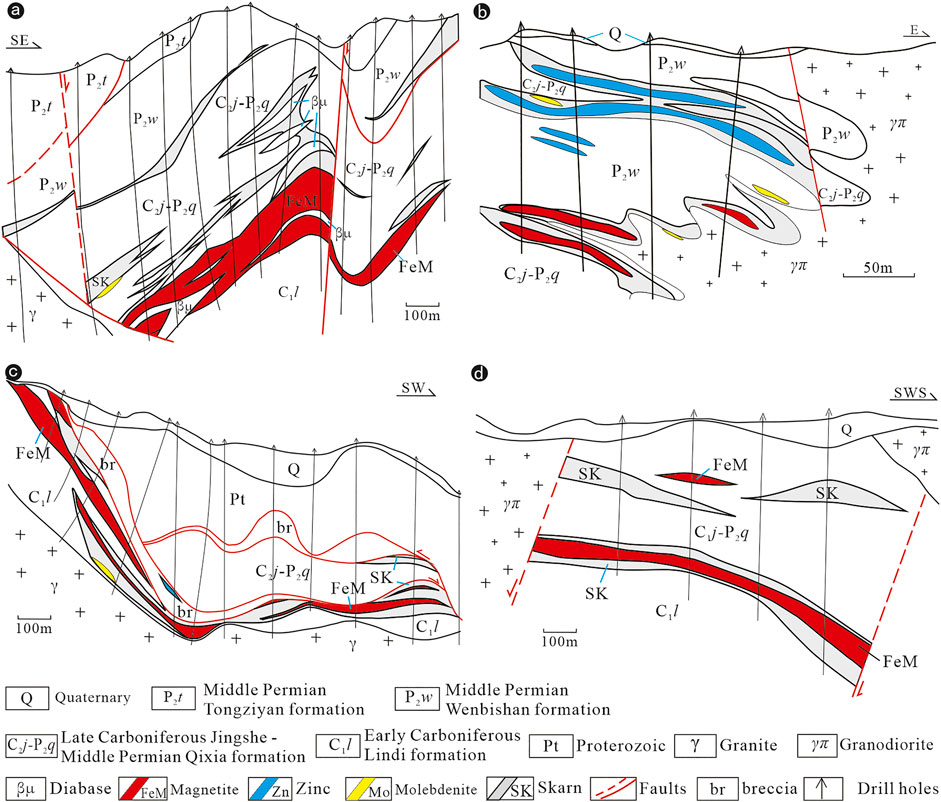
FIGURE 2. Geological Section Maps of the Makeng (A), Dapai (B), Pantian (C) and Luoyang (D) Fe-polymetallic deposits.
Ore features
As one of the most important super large iron deposits in South China, the Makeng iron polymetallic deposit was taken as an example to display its ore features in this paper. The Makeng iron deposit is characterized by thick and large single orebody with a maximum thickness of >50 m (>200 m in the Makeng deposit), but it shows remarkable variations in different positions due to the control of folds and faults. The main ore bodies formed in the contact zone between the Early Carboniferous clastic rocks (C1l) and Late Carboniferous-Middle Permian carbonate rocks (C2j-P2q) with bedded and para-bedded shapes. Magnetite is the major metal-bearing mineral in these deposits, with some hematite, pyrite, molybdenite and sphalerite. As a kind of later hydrothermal modified mineral, molybdenite is often filled in the fracture surface of wall rocks and iron ores with vein and scattered shapes. Garnet and diopside is the primary gangue minerals and they are closely associated with the iron-rich ores. The garnet associated with magnetite is reddish brown and dark in color, which has typical characteristics of andradite garnet. In addition, vein magnetite is often observed in the mineralized bodies, and they are always accompanied by skarn minerals. The iron ores mainly show semi-euhedral to euhedral medium—coarse granular texture, with a small amount of metasomatic texture. Dense massive structure is the most important ore structure in the Makeng deposit, accounting for more than 70%. Skarn is the most important alteration type in this deposit. Associated with magnetites, the garnet and diopside accounted for a vast majority of the altered minerals. Despite it has large size of iron ore bodies and the wide variety of skarn minerals, there is no obvious zonation of skarn observed in the mine.
Sampling and analytical methods
Sample description
Samples of garnet skarn collected from the Makeng, Luoyang, Dapai and Pantian deposits were selected to carry out LA-ICPMS garnet U-Pb dating in this paper. A total of nine samples were collected from the mine channel and drill holes of the Makeng (102-2-b4, 108-1-b6, ZK7525-b1, and 214-b9), Luoyang (ZK405-b13 and BL23), Dapai (ZK403-b92 and ZK403-b67), and Pantian (PTPD-b1) iron polymetallic ore deposits. These samples were collected from the ore-bearing garnet skarn in different deposits and different orebodies of a same deposit. The garnets were concomitant with magnetites in these selected samples. Magnetite was the main ore mineral with little pyrite, pyrrhotite and chalcopyrite, along with garnet as major gangue mineral. Micrographs of representative samples showed that garnet was formed with good crystal morphology and closely association with magnetite in space (Figure 3). The garnets have euhedral and semi-euhedral granular textures with crystal size ranging from 200 to 500 μm, with typical growth bands developed locally.
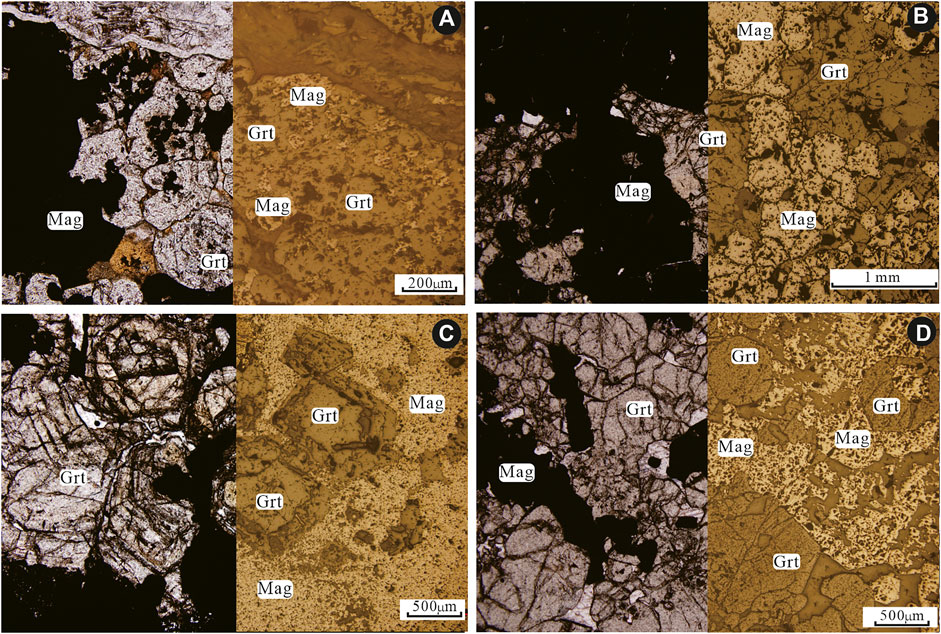
FIGURE 3. Microphotographs showing the accompanying relationship between garnets and Magnetites from Makeng (A), Luoyang (B) Dapai (C) and Pantian (D) deposits. (The left photos are cross-polarized light; the right photos are plane-polarized light). Gr—Garnet; Mag—Magnetite.
Analytical method
These spots with no cracks and inclusions were selected from each thin section of these samples to carry out the experiment. Garnet U-Pb dating and rare element analysis was performed using a GeoLasHD ArF laser ablation (LA) and an Agilent 7900 inductively coupled plasma mass spectrometer (ICP-MS) at the Key Laboratory of Paleomagnetism and Tectonic Reconstruction, Ministry of Natural Resources, Beijing, China. A detailed introduction to the instrumental conditions was described in Wang et al. (2022). A spot beam size of 90 μm was used during the analysis, and the garnet Willsboro (Seman et al., 2017) was used as an external standard to test the isotope ratios of the samples. Detailed instrument parameters and analytical methods were listed in Table 1. After the analyses, ICPMSDataCal software (version 10.9) was applied to calculate the 207Pb/206Pb, 206Pb/238U, 207Pb/235U and 208Pb/232Th ratios (Liu et al., 2010). Tera-Wasserburg lower intercept ages were calculated using ISOPLOT 3.0 with quotes at the 1σ and 95% confidence levels (Ludwig, 2003).
The experimental conditions and instrument parameters for in-situ rare Earth element analysis were the same as those for U-Pb dating, and it was done at the same time as U-Pb isotope analysis. The synthetic glass samples NIST 610 and NIST 612 were used as external standards to test the rare Earth element contents. ICPMSDataCal software (version 10.9) was applied to calculate the trace element contents (Liu et al., 2010).
Results
Rare earth element analysis results
The rare Earth element analysis results are shown in Table 2. A total of 25 and 32 spots of garnet sample ZK7525-b1 from the Makeng deposit and ZK405-b13 from the Luoyang deposit were selected to carry out rare Earth element analysis, respectively. Both of the two samples had lower REE contents with total REE contents (∑REE) of 22.29–68.26 ppm (average value of 38.22 ppm) and 26.41–66.56 ppm (average value of 48.78 ppm), respectively. They were enrichment in light rare Earth elements with positive Eu anomalies. These samples showed right-sloping features in the chondrite-normalized REE patterns (Figure 4). Representative garnet sample ZK403-b67 and PTPD-b1 from Dapai and Pantian deposits had lower REE contents, with total REE contents (∑REE) of 216.49–526.53 ppm (n = 26, average value = 349.14 ppm) and 117.55.41–396.30 ppm (n = 23, average value = 278.74 ppm), respectively. They showed flat REE distribution curves with weak negative Eu anomalies on the chondrite-normalized REE patterns (Figure 4).

TABLE 2. Rare Earth element analytical results (10−6) of garnets from the Makeng-style Fe-polymetallic deposits.
U-Pb dating results
The LA-ICPMS garnet U-Pb analysis results were listed in Table 3. Four ore-bearing garnet samples (102-2-b1, 108-1-b6, ZK7525-b1, and 214-b9) were collected from different orebodies of the Makeng iron polymetallic deposit to analyze the U-Pb isotopic ratios. These spots of each sample showed good linear distribution features in the Tera-Wasserburg diagrams (Figures 5A–D). It yielded lower interception ages of 133.3 ± 2.5 Ma, 130.4 ± 4.6 Ma, 132.6 ± 3.5 Ma and 130.3 ± 8.6 Ma, respectively. A total of 17 and 28 spots were selected for two samples (ZK405-b13 and BL23) from the Luoyang deposit, which exhibited linear features on the Tera-Wasserburg diagram (Figures 5E,F) and yielded lower interception ages of 137.5 ± 3.7 Ma and 136.9 ± 3.0 Ma, respectively. A total of 25 and 30 spots were selected for two samples (ZK403-b92 and ZK403-b67) from the Dapai deposit, and it yielded lower interception ages of 130.9 ± 2.5 Ma and 132.1 ± 2.0 Ma respectively (Figures 5G,H). A total of 26 spots were selected for sample PTPD-b1 collected from the Pantian deposit, yielding a lower interception age of 133.8 ± 3.3 Ma. Although these spots did not show a good linear feature, they were located near the concordant curve (Figure 5I), and therefore the lower interception age can represent the forming time of the garnet.

TABLE 3. LA-ICPMS garnet U-Pb data for skarn rocks from the Makeng-style iron polymetallic deposits.
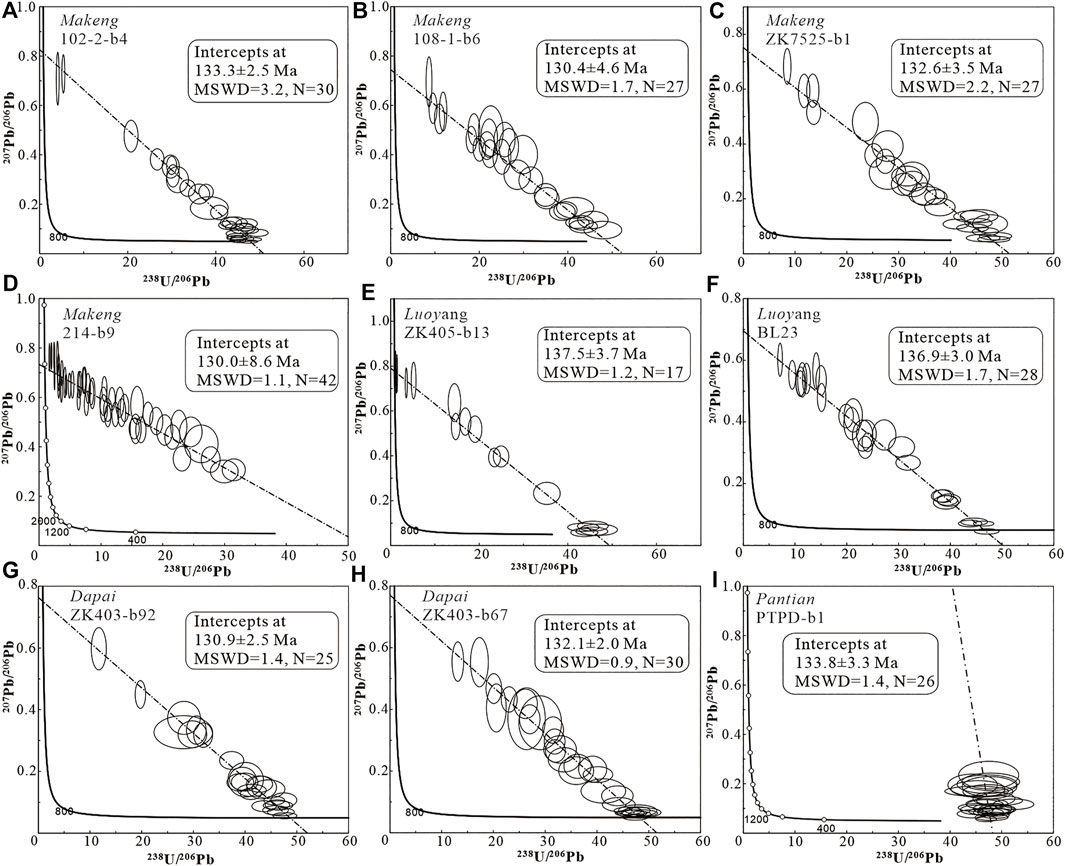
FIGURE 5. Tera-Wasserburg lower interception ages of Garnet from Makeng-style iron deposits. MSWD, mean squared weighted deviation; N, number of the spots.
From a general view, the U-Pb ages of garnet skarn from the Makeng-style deposits are close with relatively concentrated ages ranging from 137 Ma to 130 Ma.
Discussion
Mineralization age
Dating the mineralization age is an important part in the ore genesis research, and the uncertainty of mineralization age will affect our understanding on the ore genesis. Due to the controversy on the mineralization age, there has been different understanding on the generation of the Makeng-style deposits, such as the sedimentary modified genesis and magmatic-hydrothermal genesis hypothesis (Han and Ge, 1983; Chen et al., 1985; Zhang et al., 2012b; Zhang et al., 2013; Wang et al., 2021). Previous research on the Makeng-style deposits mainly concentrated on zircon U-Pb dating for granites and Re-Os dating for molybdenites in ore districts (Zhang et al., 2018a; Zhang et al., 2012b; Lai et al., 2014; Yuan et al., 2014; Zhang et al., 2015; Zhao et al., 2016; Wang et al., 2018b), but the molybdenites were usually found in the interior of granite bodies and the fracture surface of the iron ores. Thus far, there is still no strongly evidence to prove that the magnetite mineralization is related to the intrusive rocks, or the magnetite are simultaneous with the molybdenites because they are not associated in space.
The ore-bearing garnet skarn rocks were selected to carry out LA-ICPMS garnet U-Pb dating, which can more directly constrain the mineralization age of the Makeng-style deposits because the garnet was always concomitant with the magnetite in space. Four representative ore-bearing garnet samples from different orebodies of the Makeng deposit yielded lower interception ages of 133.3 ± 2.5 and 130.4 ± 4.6 Ma, 132.6 ± 3.5 Ma and 130.0 ± 8.6 Ma, respectively. These garnet U-Pb ages were close to each other and consistent with the zircon U-Pb dating results reported by Zhang et al. (129.6 ± 0.8 and 132.6 ± 1.3 Ma, Zhang et al., 2012b) and Wang et al. (132.0 ± 0.6 Ma and 132.4 ± 0.8, Wang et al., 2015). In addition, the garnet and zircon U-Pb ages are close to the molybdenite Re-Os dating results with model ages ranging from 131.9 ± 1.9 to 133.3 ± 2.3 Ma (Zhang et al., 2012b).
To determine if the ore-forming ages were consistent among different deposits, five representative ore-bearing garnet samples from Luoyang, Dapai and Pantian were selected for U-Pb dating and yielded similar U-Pb ages. Two garnet samples from the Luoyang deposit yielded lower interception ages of 137.5 ± 3.7 Ma and 136.9 ± 3.0 Ma respectively, which are close to the zircon U-Pb ages of 137.2 ± 2.3 Ma (Zhang et al., 2018b) and 131.6 ± 0.6 Ma (Wang et al., 2021), and the molybdenite Re-Os ages of 133.0 ± 1.9 Ma, 133.1 ± 1.9 Ma and 134.0 ± 4.2 Ma (Zhang et al., 2012b). Two samples selected from the Dapai deposit yielded lower interception ages of 130.9 ± 2.5 Ma and 132.1 ± 2.0 Ma respectively, which were consistent with the zircon U-Pb ages of 132.4 ± 0.8 Ma (Yuan et al., 2020) and molybdenite Re-Os age of 133.5 ± 4.1 Ma (Zhao et al., 2016). One sample collected from the Pantian deposit yielded a lower interception age of 133.8 ± 3.3 Ma, which was close to the zircon U-Pb age of 131.7 ± 0.5 Ma (Lai et al., 2014).
Together with the zircon U-Pb and molybdenite Re-Os dating results mentioned above and our new garnet U-Pb analysis results, we can draw a conclusion that the mineralization age constrained by associated minerals of Makeng-style deposits mainly concentrated around 137 Ma to 130 Ma (Table 4). This research can well resolve the disagreement about the mineralization age of the Makeng-style deposits due to a lack of direct chronological evidence. It shows that the magnetite and molybdenite are nearly simultaneous and consistent with the emplacement age of the Cretaceous granites, which indicates that the magnetite mineralization may be related to the granites.
Ore deposit type
The ore genesis of the Makeng-style Fe polymetallic deposits has been a controversial issue since they were discovered, and different genesis theories exist such as the marine sedimentation and hydrothermal modification, strata-bound skarn alteration, and silica-calcareous-plane mineralization hypotheses (Han and Ge, 1983; Wang et al., 2018a). A major reason for the controversy is the lack of direct chronological constraints. Magnetite ore bodies of the Makeng-style deposits mainly formed on the interface between Lower-Middle Permian carbonates and Late Devonian—Early Carboniferous clastic rocks, which caused the controversial understanding on the relationship between the mineralization and the granites. In addition, zircon U-Pb ages show that emplacement of the granites occurred in two main stages: ca. (160–150) Ma and ca. (135–130) Ma (Yan, 2013; Yu, 2017; Yuan et al., 2020); thus, it yields a significant controversy on the genesis due to the lack of more direct evidences and the different interpretation of the mineralization age. In this paper, ore-bearing garnet samples collected from different orebodies and ore deposits were selected to provide new direct chronological constraints on ore genesis, and all the garnet U-Pb dating results for these four deposits were close overall, which indicated that the mineralization of Makeng-style deposits was related to Cretaceous granites (ca. 137–130 Ma).
The rare Earth element analysis results of representative ore-bearing garnet samples showed that the REE contents and chondrite-normalized REE patterns were distinct between different deposits. The total REE contents of garnet samples from the Makeng and Luoyang deposits were relatively low (22.29–68.26 ppm and 26.41–66.56 ppm) with features LREE (light rare Earth element) enrichment and HREE (heavy rare Earth element) depletion and positive Eu anomalies. The rare Earth element distribution features were similar to those of garnet formed by magmatic hydrothermal action, and the REE distribution types were similar to granites with REE decreases in garnet due to the dilutive effect of transudation (Auwera and Andre, 1991; Hong et al., 2012). In addition, the REE distribution features are similar to those of garnets from the Huanggangliang Sn-Fe deposit (Wang et al., 2002), Huangshaping W-M-Pb-Zn deposit (Ding et al., 2018a; Ding et al., 2018b) and Mengku Fe deposit (Yang et al., 2007), and they are regarded as typical skarn polymetallic deposits. The REE contents of garnet samples from the Dapai and Pantian deposits were relatively higher than those of the Makeng and Luoyang deposits, with total REE contents (∑REE) of 216.49–526.53 ppm and 117.55.41–396.30 ppm, respectively. It showed flat features of the REE distribution curves on the chondrite-normalized REE patterns with weak negative Eu anomalies, which were different from the Makeng and Luoyang deposit. The reason for this difference may be the distinct compositions of the mineralizing fluid. These mineralized bodies of Dapai and Pantian deposits locate in the contact zone of the granites and have similar hydrothermal components, and therefore it may be a major factor causing their relatively high REE contents and negative Eu anomalies. Unlike the Dapai and Pantian deposits, mineralized bodies of the Makeng and Luoyang deposits mainly locate on the interface between the between Lower-Middle Permian carbonates and Late Devonian—Early Carboniferous clastic rocks. Therefore, it indicates that the ore-forming process may be distinct due to different mineralizing fluid for these deposits.
In summary, garnet U-Pb dating results of different deposits and different ore bodies of the same deposit showed that the ore-forming ages of the Makeng-style iron-polymetallic deposits were relatively close (concentrated among 137–130 Ma) with those of the zircon U-Pb ages of granites, indicating that the formation of magnetite was closely related to Cretaceous granite emplacement. The rare Earth element analysis results REE distribution features showed that these Makeng-style deposits are similar to typical skarn deposits with features of magmatic hydrothermal fluid, but there were some obvious differences between different deposits, indicating that there may be some differences in the mineralizing fluid and ore-forming process between different deposits.
Metallogenic tectonic setting
A large—scale magmatic activity and mineralization event occurred in eastern China during the Yanshanian period; thus, studying the geochemical dynamic background and genesis mechanism of the deposit is of great significance to understand the Mesozoic tectonic transformation in eastern China and guide ore prospecting. Determining the mineralization age is a premise and key to understand the ore genesis and metallogenic mechanism, and therefore, the purpose of this study is to accurately determine the mineralization age and provide a reference for understanding the metallogenic mechanism and tectonic background of the iron-polymetallic deposits in the western margin of the Paleo-Pacific Plate.
Located on the southeastern margin of the Cathaysian Plate, the Makeng-style iron-polymetallic deposits are controversial due to their unique metallogenic geological characteristics, especially the controversy focused on the metallogenic age and metallogenic tectonic setting (Yan, 2013; Wang et al., 2018b; Zhang et al., 2018b). Our garnet U-Pb dating results provide more direct chronological evidence for the relationship between mineralization and Cretaceous granite bodies, and it proves that mineralization occurred at approximately 137–130 Ma rather than at 150 Ma or earlier time. Previous studies showed that the South China continent underwent a tectonic transition in the Early Cretaceous, that is, the transition from a compressional tectonic system dominated by intracontinental orogeny in the middle and late Jurassic to an extensional tectonic system in the early Cretaceous (Dong et al., 2008; Xing et al., 2008; Zhang et al., 2012c; Li et al., 2012). The possible deep dynamic mechanism for this tectonic transition is the rollback of the paleo- Pacific plate with a subduction dip angle of the subducting oceanic crust plate increasing from low-angle subduction to high-angle subduction, the retreat of the trench, and thickening of the crust, which caused the extensional collapse of the thickened continental crust under a relaxed stress environment (Zhang et al., 2012c; Li et al., 2012). In addition, the metallogenic tectonic background could be reflected by research on the diagenetic tectonic environment of the granites which are closely related to mineralization. The whole-rock geochemical results indicate that the granites from the Makeng, Luoyang, Dapai, and Pantian deposits are high-Si, high-K calc-alkaline and metaluminous to weakly peraluminous rocks, with features of highly fractionated I-type granites, which reflected an extensional tectonic setting with features of the transformational tectonic environment (Zhang et al., 2012b; Lai et al., 2014; Wang et al., 2015; Wang et al., 2021). Therefore, we believe that the Makeng-style iron-polymetallic deposits may have been formed in an extensional tectonic environment caused by rollback after the subduction of the paleo-Pacific plate (Figure 6), with features of a transitional tectonic system.
Conclusion
1) The garnet U-Pb dating method was applied to reveal the mineralization age and genesis of Makeng-style deposits, yielding 137–130 Ma ages for nine ore-bearing garnet samples from different deposits and orebodies of the same deposit.
2) The garnet U-Pb dating results (137–130 Ma) are consistent with the zircon U-Pb and molybdenite ages, which provides more direct evidence of the mineralization age for the Makeng-style deposits and indicates that the magnetite was closely related to Cretaceous granite emplacement.
3) Rare Earth element analysis results and REE patterns showed that there were typical skarn deposits, but obvious differences in the REE distribution types between different deposits, indicating that the ore-forming process may be distinct due to different mineralizing fluid for these deposits.
4) The Makeng-style iron-polymetallic deposits may have been formed in an extensional tectonic environment caused by rollback after subduction of the Paleo-Pacific Plate.
Data availability statement
The original contributions presented in the study are included in the article/Supplementary Material, further inquiries can be directed to the corresponding author.
Author contributions
SW: completion of manuscript KC: data treating DZ: writing guidance Others: Field and experimental assistance.
Funding
This work was supported by the Fundamental Research Projects from the Institute of Geomechanics, Chinese Academy of Geological Sciences, National Natural Science Foundation of China (No. 41873063), and projects from the China Geological Survey (No. DD20221644 and 12120113089600).
Acknowledgments
We are indebted to Yueheng Yang senior engineer from the Institute of Geology and Geophysics, Chinese Academy of Sciences, for his kind assistance in providing standard samples. Great thanks to the reviewers and editors for their helpful comments.
Conflict of interest
The authors declare that the research was conducted in the absence of any commercial or financial relationships that could be construed as a potential conflict of interest.
Publisher’s note
All claims expressed in this article are solely those of the authors and do not necessarily represent those of their affiliated organizations, or those of the publisher, the editors and the reviewers. Any product that may be evaluated in this article, or claim that may be made by its manufacturer, is not guaranteed or endorsed by the publisher.
References
Auwera, J. V., and Andre, L. (1991). Trace elements (REE) and isotopes (O, C, Sr) to characterize the metasomatic fluid sources: Evidence from the skarn deposit (Fe, W, Cu) of traversella (ivrea, Italy). Contr. Mineral. Pet. 106, 325–339. doi:10.1007/bf00324561
Chen, S. R., Xie, J. H., Xu, C. N., and Guo, W. W. (1985). The origin of makeng iron deposit, fujian. Geochimica 4, 350–357. doi:10.19700/j.0379-1726.1985.04.008
Chen, W., Zhang, W. Q., Simonetti, A., and Jian, S. Y. (2016). Mineral chemistry of melanite from calcitic ijolite, the Oka carbonatite complex, Canada: Implications for multi-pulse magma mixing. J. Earth Sci. 27, 599–610. doi:10.1007/s12583-016-0715-3
Deng, X. D., Li, J. W., Luo, T., and Wang, H. Q. (2017). Dating magmatic and hydrothermal processes using andradite-rich garnet U–Pb geochronometry. Contrib. Mineral. Pet. 172, 71–81. doi:10.1007/s00410-017-1389-2
Ding, T., Ma, D. S., Lu, J. J., and Zhang, R. Q. (2018b). Magnetite as an indicator of mixed sources for W-Mo-Pb-Zn mineralization in the Huangshaping polymetallic deposit, southern Hunan Province, China. Ore Geol. Rev. 95, 65–78. doi:10.1016/j.oregeorev.2018.02.019
Ding, T., Ma, D. S., Lu, J. J., and Zhang, R. Q. (2018a). Garnet and scheelite as indicators of multi-stage tungsten mineralization in the Huangshaping deposit, southern Hunan province, China. Ore Geol. Rev. 94, 193–211. doi:10.1016/j.oregeorev.2018.01.029
Dong, S. W., Zhang, Y. Q., Long, C. X., Yang, Z. Y., Ji, Q., Wang, T., et al. (2008). Jurassic tectonic revolution in China and new interpretation of the "yanshan movement. Acta Geol. Sin. 82, 334–347. doi:10.1111/j.1755-6724.2008.tb00583.x
Duan, Z., Gleeson, S. A., Gao, W. S., Wang, F. Y., and Li, J. W. (2020). Garnet U-Pb dating of the Yinan Au-Cu skarn deposit, Luxi District, North China Craton: Implications for district-wide coeval Au-Cu and Fe skarn mineralization. Ore Geol. Rev. 118, 103310–103318. doi:10.1016/j.oregeorev.2020.103310
Han, F., and Ge, C. H. (1983). Geological and geochemical characteristics of the marine volcanic hydrothermal - sedimentary origin of Makeng iron ore deposit in Fujian Province (in Chinese). Annu. Rep. Chin. Acad. Geol. Sci. 8, 154–156.
Hong, W., Zhang, Z. H., Jiang, Z. S., Li, F. M., and Liu, X. (2012). Magnetite and garnet trace element characteristics from the Chagangnuoer iron deposit in the Western Tianshan Mountains, Xinjiang, NW China: Constrain for ore Genesis (in Chinese with English abstract). ActaPetrologica Sin. 28, 2089–2102.
Lai, S. H., Chen, R. Y., Zhang, D., Di, Y. J., Gong, Y., Yuan, Y., et al. (2014). Petrogeochemical features and zircon LA-ICP-MS U-Pb ages of granite in the Pantian iron ore deposit, Fujian Province and their relationship with mineralization (in Chinese with English abstract). Acta Petrol. Sin. 30, 1780–1792.
Li, D. F., Fu, Y., and Sun, X. M. (2018). Onset and duration of Zn-Pb mineralization in the Talate Pb-Zn (-Fe) skarn deposit, NW China: Constraints from spessartine U-Pb dating. Gondwana Res. 63, 117–128. doi:10.1016/j.gr.2018.05.013
Li, J. H., Zhang, Y. Q., Dong, S. W., and Li, H. L. (2012). Late mesozoic–early cenozoic deformation history of the yuanma basin, central South China. Tectonophysics 570-571, 163–183. doi:10.1016/j.tecto.2012.08.012
Liu, Y. S., Hu, Z. C., Zong, K. Q., Gao, C. G., Chen, H. H., Xu, J., et al. (2010). Reappraisement and refinement of zircon U-Pb isotope and trace element analyses by LA-ICP-MS. Chin. Sci. Bull. 55, 1535–1546. doi:10.1007/s11434-010-3052-4
Ludwig, K. R. (2003). Isoplot 3.00: A geochronological toolkit for microsoft excel. California, Berkeley: Berkeley Geochronology Center.
Seman, S., Stockli, D. F., and Mclean, N. M. (2017). U-Pb geochronology of grossular-andradite garnet. Chem. Geol. 460, 106–116. doi:10.1016/j.chemgeo.2017.04.020
Stifeeva, M., Salnikova, E., Samsonov, A. V., Kotov, A. B., and Gritsenko, Y. D. (2019). Garnet U–Pb age of skarns from dashkesan deposit (lesser caucasus). Dokl. Earth Sc. 487, 953–956. doi:10.1134/S1028334X19080178
Tang, Y. W., Gao, J. F., Lan, T. G., Cui, K., Han, J. J., Zhang, X., et al. (2021). In situ low-U garnet U-Pb dating by LA-SF-ICP-MS and its application in constraining the origin of Anji skarn system combined with Ar-Ar dating and Pb isotopes. Ore Geol. Rev. 130, 103970–104015. doi:10.1016/j.oregeorev.2020.103970
Wafforn, S., Seman, S., Kyle, J. R., Stockli, D., Cloos, M., Sonbait, D., et al. (2018). Andradite garnet U-Pb geochronology of the big Gossan skarn, Ertsberg-Grasberg mining district, Indonesia. Econ. Geol. 113, 769–778. doi:10.5382/econgeo.2018.4569
Wang, D. H., Chen, Z. H., Chen, Y. C., and Tan, J. X. (2010). New data of the rock forming and ore-forming chronology for China's important mineral resources areas (in Chinese with English abstract). Acta Geol. Sin. 84, 1030–1040.
Wang, L. J., Wang, J. B., Wang, Y. W., and Shimazaki, H. (2002). REE geochemistry of the Huangguangliang skarn Fe-Sn deposit, Inner Mongolia (in Chinese with English abstract). Acta Petrol. Sin. 18, 575–584.
Wang, S., Zhang, D., Vatuva, A., Yan, P. C., Ma, S., Feng, H. B., et al. (2015). Zircon U-Pb geochronology, geochemistry and Hf isotope compositions and their implications of the dayang and juzhou granites from longyan area in fujian province(in Chinese with English abstract). Geochemica 44, 440–468.
Wang, S., Zhang, D., Wu, G. G., Cao, K., Qu, H. J., Ma, S., et al. (2017a). New geochronologic evidence of diabases and their metallogenic relationship with the Makeng-type iron deposits in Southwest Fujian, SE China. Acta Geol. Sin. - Engl. Ed. 91, 2324–2326. doi:10.1111/1755-6724.13473
Wang, S., Zhang, D., Wu, G. G., Vatuva, A., Di, Y. J., Yan, P. C., et al. (2017b). Late Paleozoic to Mesozoic extension in southwestern Fujian Province, South China: Geochemical, geochronological and Hf isotopic constraints from basic-intermediate dykes. Geosci. Front. 8, 529–540. doi:10.1016/j.gsf.2016.05.005
Wang, S., Zhang, D., Wu, G. G., Yi, J. J., and Li, X. J. (2018a). Metallogenic structctural plane characteristics and its prospecting importance for makeng type Fe deposits in southwestern fujian province (in Chinese with English abstract). J. Geomechanics 24, 199–211. doi:10.12090/j.issn.1006-6616.2018.24.02.021
Wang, S., Zhang, D., Yu, T. D., Wu, G. G., Di, Y. J., Zhang, Y. Y., et al. (2021). Geochronology and S-Pb-O-H isotopic constraints on the generation of the Luoyang Fe deposit in southwest Fujian Province, SE China. Resour. Geol. 71, 63–79. doi:10.1111/rge.12247.1111/rge.12247
Wang, S., Zhang, S. H., Zhag, Q. Q., Liang, X., Kong, L. H., Hu, G. H., et al. (2022). In-situ zircon U-Pb dating method by LA-ICP-MS and discussions on the effect of different beam spot size on the dating results (in Chinese with English abstract). J. geomechanics 28, 642–652. doi:10.12090/j.issn.1006-6616.2021140
WangZhang, S. D., Wu, G. G., Yi, J. J., Li, X. J., Gao, X. Q., Vatuva, A., et al. (2018b). Late mesozoic tectonic evolution of southwestern fujian province, South China: Constraints from magnetic fabric, zircon U-Pb geochronology and structural deformation. J. Earth Sci. 29, 391–407. doi:10.1007/s12583-017-0968-5
Xing, G. F., Lu, Q. D., Chen, R., Zhang, Z. Y., Nie, T. C., Li, L. M., et al. (2008). Study on the ending time of late mesozoic tectonic regime transition inSouth China: Comparing to the yanshan area in north China (in Chinese with englis abstract). Acta Geol. Sin. 82, 451–463.
Yan, P. C. (2013). Discussion the genesis of Makeng iron ore-deposit, Fujian Province (in Chinese with English abstract). Beijing: China University of Geosciences, 1–84.
Yang, F. Q., Mao, J. W., Xu, L. G., Zhang, Y., and Liu, F. (2007). REE geochemitry of the Mengku iron deposit, Xinjiang, and its indication for iron mineralization (in Chinese with English abstract). Petrol. Sin. 23, 2443–2456.
Yang, Y. L., Ni, P., Pan, J. Y., Wang, G. G., and Xu, Y. F. (2017). Constraints on the mineralization processes of the Makeng iron deposit, eastern China: Fluid inclusion, H-O isotope and magnetite trace element analysis. Ore Geol. Rev. 88, 791–808. doi:10.1016/j.oregeorev.2016.11.018
Yu, T. D. (2017). The "Three-in-One" characteristics and metallogenic mechanism of Luoyang iron ore in zhangping city, fujian province (in Chinese with English abstract). Beijing: China University of Geosciences, 1–70.
Yuan, Y. (2020). Petrogenesis of early cretaceous granitoids and Fe-Mo polymetallic mineralization in yongding—dehua area. Beijing: China University of Geosciences, 1–221.
Yuan, Y., Zhang, D., Feng, H. B., Di, Y. J., Wang, C. M., and Ni, J. H. (2014). The Re-Os isotope geochronology of Dapai iron polymetallic ore deposit in Yongding County, Fujian Province and its genetic significance. Acta Geol. Sin. - Engl. Ed. 88, 1025–1026. doi:10.1111/1755-6724.12378_30
Zhang, C. S., Li, L., Zhang, Q. Q., and Wang, J. R. (2012a). LA-ICP-MS zircon U-Pb ages and Hf isotopic compositions of Dayang granite from Longyan, Fujian Province (in Chinese with English abstract). Geoscience 26, 433–544.
Zhang, C. S., Mao, J. W., Zhang, C. Q., and Yu, M. (2013). Fluid inclusion characteristics and metallogenic mechanism of Makeng skarn Fe-Mo deposit in Fujian Province (in Chinese with Englis abstract). Mineral. Deposits 32, 390–396.
Zhang, D., Wu, G. G., Di, Y. J., Wang, C. M., and Yao, J. M. (2012b). Geochronology of diagenesis and mineralization of the Luoyang iron deposit in Zhangping city, Fujian province and its geological dignificance (in Chinese with English abstract). Earth Sci. 37, 1217–1231. doi:10.3799/dqkx.2012.130
Zhang, X. D., Meng, X. H., Chen, Z. X., Wang, J., and Xiu, C. X. (2018a). Comprehensive study of the geological and geophysical characteristics of the metallogenic belt in Southwest Fujian-A case study in the Yongding-Dapai polymetallic ore deposit (in Chinese with English abstract). Chin. J. Geophys. 61, 1588–1595. doi:10.6038/cjg2018L0666
Zhang, Y. Q., Dong, S. W., Li, J. H., Cui, J. J., Shi, W., Su, J., et al. (2012c). The new progress in the study of Mesozoic tectonics of South China (in Chinese with English abstract). Acta Geol. Sin. 33 (03), 257–279. doi:10.3975/cagsb.2012.03.01
Zhang, Z. J., Cheng, Q. M., Yang, J., and Hu, X. L. (2018b). Characterization and origin of granites from the Luoyang Fe deposit, southwestern fujian province, South China. J. Geochem. Explor. 184, 119–135. doi:10.1016/j.gexplo.2017.10.015
Zhang, Z. J., Zuo, R. G., and Cheng, Q. M. (2015). The mineralization age of the makeng Fe deposit, South China: Implications from U-Pb and Sm-Nd geochronology. Int. J. Earth Sci. 104, 663–682. doi:10.1007/s00531-014-1096-4
Zhang, Z. J., and Zuo, R. G. (2014). Sr-Nd-Pb isotope systematics of magnetite: Implications for the Genesis of Makeng Fe deposit, southern China. Ore Geol. Rev. 57, 53–60. doi:10.1016/j.oregeorev.2013.09.009
Zhang, Z., and Zhang, C. S. (2014). Skarn mineral characteristics and zonation of the Makeng Fe-Mo deposit in Fujian Province. Acta Petrol. Sin. 30, 1339–1354.
Keywords: garnet U-Pb dating, ore genesis, makeng-type deposits, mineralization age, southweatern fujian
Citation: Wang S, Cao K, Zhang D, Yi J-J, Hu B-J, Yang J, Cai M-Y, Zhang Y-Y, Yuan Y and Pan T-W (2023) Mineralization age and genesis of the makeng-style iron deposits in the Paleo-Pacific tectonic domain of South China: In situ LA-ICPMS garnet U-Pb chronological and geochemical constraints. Front. Earth Sci. 10:1027620. doi: 10.3389/feart.2022.1027620
Received: 25 August 2022; Accepted: 07 November 2022;
Published: 26 January 2023.
Edited by:
Fei Xue, Hohai University, ChinaReviewed by:
Teng Ding, Hohai University, ChinaHailong Huo, Chinese Academy of Geological Sciences (CAGS), China
Copyright © 2023 Wang, Cao, Zhang, Yi, Hu, Yang, Cai, Zhang, Yuan and Pan. This is an open-access article distributed under the terms of the Creative Commons Attribution License (CC BY). The use, distribution or reproduction in other forums is permitted, provided the original author(s) and the copyright owner(s) are credited and that the original publication in this journal is cited, in accordance with accepted academic practice. No use, distribution or reproduction is permitted which does not comply with these terms.
*Correspondence: Sen Wang, d2FuZ3Nlbl9jdWdAMTYzLmNvbQ==
 Sen Wang
Sen Wang Ke Cao4
Ke Cao4 Yao-Yao Zhang
Yao-Yao Zhang